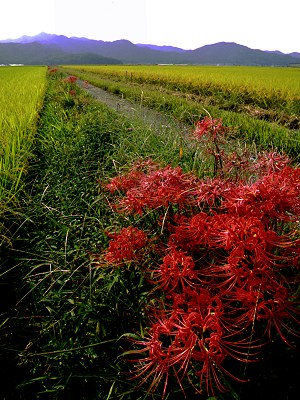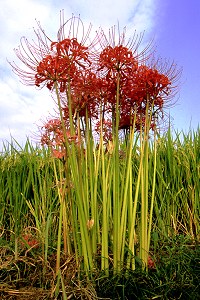HiganbanaLycoris radiata - (Red) Spider Lily
Higanbana - splashes of brilliant red fringe the paddies |
|
I've been aware of this plant for several years, but the display seems to have been particularly spectacular this year (1999). It was also right on schedule in late September -- the common Japanese name of this flower (higan + hana=flower) refers to higan, a Buddhist term for the period of seven days around the Spring or Autumn equinox.
|
|
The usual English name is "spider lily" but there are others, including apparently "naked lady". (So if you've arrived at this page by searching for 'naked Japanese lady' you may be disappointed.) I've gleaned from my reading (mostly the links below) that it originated in China; it's a member of the Amaryllis family, and is actually a cultivated variety. "Triploid" it says somewhere: I'm not too clear on the details, but I know that plants have simply no sense of social restraint when it comes to sex, throwing their chromosomes around with total abandon. The result is that this plant is sterile, only spreading as the bulbs divide. Being a simple-minded fellow, I immediately ask: "How does it cross the road, then?"
|
|
The answer seems to be that since the bulbs are well known to be distinctly poisonous (and can lead to death), they were planted around the edges of paddies and house walls to keep down pests such as mice. But they grow completely wild now, particularly also on river banks.

 Winter update
Winter update
Once you know where to look, it's quite easy to find this plant in the winter. The plants form dark clumps easily recognisable along the edges of paddy fields, and since there is a lot of sunshine in the winter months, it gets ample energy for next year's flowering effort, with little competition.
(Scene on right: in flower)
|
|
At close quarters the leaves of the plant have a very distinctive pale, almost white, stripe down the middle of each leaf. (This specimen happened to be underneath a ginkgo tree, which explains the odd-shaped pale yellow object.) Photographed in late November or December.
 Note on the English name
Note on the English name
I tracked down the "Spider lily" name by the usual method: search Japanese sites for higanbana + gakumei ("scientific name"). This gave me Lycoris radiata, and then I searched for this in English-language sites. Afterwards it occurred to me I really ought to look in a Japanese-English dictionary or two for completeness, and found that they are almost unanimous that this is called a "cluster amaryllis". Web searches for this name turned up only sites in Japan, or written by people who had visited Japan, and therefore presumably found the name from Japanese dictionaries. So it seems quite likely that the dictionaries are wrong again!
Thanks to David Cooke (Australian link below) for e-mail confirmation that the "cluster amaryllis" isn't in wide use in horticultural circles. He also mentioned "storm lily" as a name in use in Florida.
 Thumbnail gallery
Thumbnail gallery
Not an easy plant to photograph, somehow. It always grows in clumps, never quite forming a sheet of colour, but blooms looked at individually are just a tangle of spidery bits (amply justifying the English name). Or so I wrote, in October 1999. Well, it's true - the flowers do tangle up, and although sometimes it's possible to capture a flower head with individual flowers in a neat circle, they more usually stick out in all directions, making close-ups difficult. But I was also in the painful process of realising quite how limiting a cheap zoom can be. More of that some other time, but meanwhile if you want to compare, the original version of this page is here. All of the photos now on this page were taken in 2000 or 2001.












|
![]()
Links
In EnglishAmericaMississippi State University Office of Agricultural Communications: interesting article by Norman Winter
Florida Wildflower Showcase Includes an excellent image, which it calls Hurricane lily
AustraliaNotes on Lycoris Species (David Cooke) Detailed botanical explanation, including lots of hard words and some references |
In JapaneseHiroshima University Isobe-san's photos and essay, including the suggestion that higanbana was planted around paddies etc. to keep down mice and other pests. He claims that Lycoris was a sea-goddess from Greek mythology, though most people seem to think she was a mistress of Marc Antony. Could have been both, I suppose.Omachi-san[?]
Big photo, and photo of the leaves, which last through the winter (without ever looking very exciting)
Abiko-san Three good close-ups |




